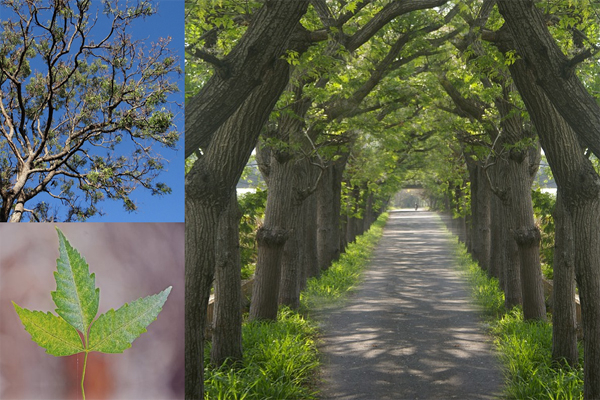The Wonder Tree of the Humid Tropics
Neem Tree
Neem tree (Azadirachta Indica or Melia Azadirachta) is a wonder tree native to parts of South Asia and other humid tropics is ecologically very special evergreen. It can tolerate very high levels of pollution and has the capacity to recover even if most of its foliage is dropped. It can reach heights of 30 meters and live for over two centuries. Its deep root system is very well adapted to retrieving water and nutrients from the various soil profile even shallow, infertile, stony and acidic soils, but sensitive to boggy, watery soil. The trees begin their reproductive stage at about three to five years of age, and become fully reproductive when they are ten years old.
Trees with a large leaf area such as neem, accumulate relatively higher quantities of lead, has huge capacity to absorb many pollutants like particulate dust, CO2, oxides of sulphur, nitrogen and other polutants. Increasing the number of neem trees would have great impact in improving human and environmental health, especially in the areas where polution and health problems are rising. Planting more wonder trees like neem and use of its natural powers would lead to a healing chain reaction superior to any other!
Parts of neem tree have been used for thousands of years as building material, powerful herbal medicine, and safe bio-pesticide in many nations. There are reference to neem tree and its various uses in Sanskrit writings that are over 4,000 years old. It was used in Ayurvedic, Unani and traditional Asian folklore medicine, in the treatment of a wide range of afflictions (for the treatment of tetanus, urticaria, eczema, scrofula, erysipelas). It also has powerful skin rejuvenating qualities. The most frequently reported indications in ancient Ayurvedic writings are skin diseases, inflammations, leprosy, malaria, ophthalmia, tuberculosis and fevers, and more recently rheumatic disorders, treatment of acne, insect repellent and insecticide effects. Various other folk remedies for neem include use as an anthelmintic, antifeedant, antiseptic, diuretic, emmenagogue, contraceptive, febrifuge, parasiticide, pediculocide and insecticide.
It is the use of neem tree as an insecticide that now draws interest from many industrialized countries. It is seen as an environmentally safe alternative to synthetic pesticides. Researches are showing that almost 200 species of insects are affected by this trees extracts at concentrations ranging from 0.1 to 1,000 ppm, even insects that have become resistant to synthetic pesticides are controllable with the extracts from neem tree. We hope that this unique tree will be able to play much bigger role in an integrated and healthier pest management system.
Neem oil can be used as a household pesticide for ants, bedbugs, cockroaches, houseflies, sand flies, snails, termites and mosquitoes both as repellent and larvicide. Neem oil also controls black spot, powdery mildew, anthracnose and rust (fungus).
Formulations made of Neem oil also find wide usage as a bio-pesticide for organic farming, as it repels a wide variety of pests including the mealy bug, beet armyworm, aphids, the cabbage worm, thrips, whiteflies, mites, fungus gnats, beetles, moth larvae, mushroom flies, leafminers, caterpillers, locust, nematodes and the Japanese beetle. Neem Oil is not known to be harmful to mammals, birds or some beneficial insects such as earthworms, butterflies, honeybees and ladybugs.
BIO PESTICIDE
For use as a bio-pesticide, pure Neem oil should be diluted at the rate of 1 teaspoon per quart, or 4 teaspoons per gallon of water (metric: 5.2 millilitres per litre) and used as a foliar spray or used as a soil drench at the rate of 1 liter per square meter of soil (3 ounces per square foot). Adding a surfactant greatly enhances its effectiveness. Ordinary liquid dishwashing soap may be used as a surfactant, added at the rate of 1 tablespoon per gallon. (source: Wikipedia).
HUMAN USE
Neem tree has also a long record of safety to human health and wide acceptability as a herbal medicine. Neem offers a non-toxic alternative to powerful and sometimes damaging prescription medicines. Every part of this fascinating tree is packed with anti-bacterial, anti-fungal, anti-histamine, anti-septic, anti-viral, and immune stimulating compounds for treating hundreds of maladies. It boosts the immune system on all levels while helping the body fight infection even before the immune system is called into action. Unlike synthetic antibiotics, neem does not destroy beneficial bacteria and other micro organisms needed to maintain optimum health.
Neem oil has an extensive history of human use in India, Pakistan, Bangladesh and surrounding regions for a variety of therapeutic purposes. Neem oil is made from the leaves and bark of the neem tree. It is generally light to dark brown, bitter and has strong odour (like combination of the odours of peanut and garlic). In India, Pakistan and Bangladesh, it is used for preparing cosmetics products like: soap, hair products, body hygiene creams, hand creams etc.
Related Links:
 The Hydrologic Cycle - A Multi-Phased Journey
The Hydrologic Cycle - A Multi-Phased Journey

Education
Many people benefit from knowledge and interesting facts...Did You Know?
When precipitation falls over the land surface, it follows various routes. Some of it evaporates, returning to the atmosphere, and some seeps into the ground (as soil moisture or groundwater). Groundwater is found in two layers of the soil, the "zone of aeration," where gaps in the soil are filled with both air and water, and, further down, the "zone of saturation," where the gaps are completely filled with water. The boundary between the two zones is known as the water table, which rises or falls as the amount of groundwater increases or decreases.
The water table is the top of the zone of saturation and intersects the land surface at lakes and streams. Above the water table lies the zone of aeration and soil moisture belt, which supplies much of the water needed by plants.
Throughout the hydrologic cycle, there are an endless number of paths that a water molecule might follow.

